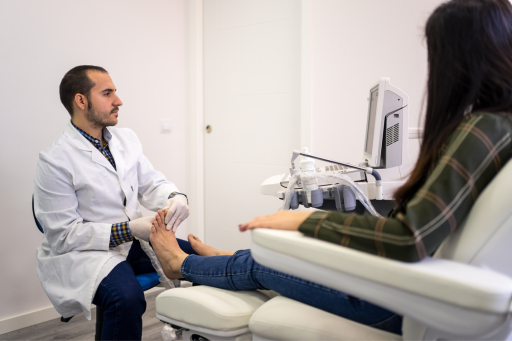Chiropodist vs Podiatrist: What is the difference
When it comes to foot health, two professionals often come up in conversation: chiropodists and podiatrists. These terms can be confusing, especially since both roles focus on treating the feet. Despite the overlapping functions, there are key differences for podiatrists vs chiropodists that can impact the type of care you receive. Understanding these distinctions will help you choose the right specialist for your needs and ensure that your feet are in the best possible hands. Let’s understand the roles and responsibilities of both professionals in detail.
What is Chiropodist?
A chiropodist is a healthcare professional who treats and diagnoses foot-related conditions like corns, ingrown toenails, calluses, etc., to ensure proper foot hygiene. The first name that comes to the mind of patients when they suffer from foot-related issues is a chiropodist.

What is Podiatrist?
There is a slight difference between a chiropodist vs podiatrist. You can say that the podiatrist is a modern version of a chiropodist. A podiatrist is given extensive training to treat a broad spectrum of foot and ankle issues related to diseases like arthritis and diabetes.
What Do Chiropodist and Podiatrists Do?
Let’s first understand what does a chiropodist do. They are more inclined to manage the routine aspects of foot care, which involves fungal infections, calluses, and corns. They can also provide you with orthotic devices. These devices are custom-made shoe inserts that you can purchase at your local pharmacy to alleviate foot pain and correct abnormal walking patterns. Thus, they play a crucial role in preventive care to keep serious foot problems at bay and address minor issues early.
Now, what does a podiatrist do? They treat more complex problems like fractures, injuries, and foot deformities. Their qualification allows them to perform surgeries and administer medications. Their advanced training plays a vital role in preventing severe outcomes like amputations.

What Are the Differences Between a Chiropodist and a Podiatrist?
Let’s decode the differences between the two professions –
Training and Education
The first difference in podiatrist vs chiropodist is in their training and education. Both have to pass provincial licensing exams to obtain a license for their practice in addition to their university-level schooling.
Every state has its own specific requirements for becoming a podiatrist. The general requirement is to attain a bachelor’s degree that is the Doctor Of Podiatric Medicine (DPM) which includes classroom instructions and hands-on clinical experience.
Chiropodists, while still highly trained, may have less rigorous educational requirements depending on their location. The majority of them hold a post-secondary diploma in Chiropody. An important point here to note is that both the chiropodist and podiatrist are not medical doctors.
Treatment
When it comes to podiatrists vs chiropodists, both physicians can treat common foot ailments like bunions, flat feet, calluses warts, and plantar fasciitis. Besides, a person of any age can come to them for treatment. Both chiropodists and podiatrists help keep foot injuries and foot trauma away.
Surgery
Podiatrists are the ones who have been given training in the US before 1993. So, their scope of practice is quite vast, including bone surgery in the foot. The thing you should keep in mind is that most patients in Ontario prefer seeing the Orthopedic Surgeons as the cost is covered by the Ontario Health Insurance Plan.
On the other hand, chiropodists can perform the basic foot care but cannot perform the surgical ones or order diagnostic X-rays.
How Does It Work When You Visit a Podiatrist or Chiropodist?
The first step, whether you visit a podiatrist or chiropodist, is the assessment of your foot health, where your symptoms, medical history, and lifestyle factors are discussed.
Talking about podiatrists vs chiropodists, a podiatrist goes more in-depth to diagnose and treat your problem, and they might do a diagnostic test or recommend a surgical procedure if necessary.
On the flip side, a chiropodist focuses on treating common foot problems like designing orthotic devices, removing corns, or trimming thickened toenails. They also offer suitable advice on proper footwear and foot hygiene.
Final Thoughts
Understanding the differences for a podiatrist vs chiropodist is crucial for making informed decisions about your foot care. While both professionals are trained to address foot health issues, podiatrists typically have more advanced training and a broader scope of practice, allowing them to treat more complex conditions and perform surgeries.
Ultimately, both chiropodists and podiatrists play vital roles in maintaining foot health, helping you stay active and pain-free. If you’re experiencing foot discomfort or noticing changes in your foot health, don’t hesitate to seek professional advice from Mankind Rehab Center. Early intervention can prevent minor issues from becoming major problems, ensuring that your feet remain healthy and strong for years to come. So, let our rehab center in Brampton treat you in the best possible way and help restore your body’s strength. Contact us at +1-289-946-0898 or mankindrehabcentreinc@gmail.com to know more.












